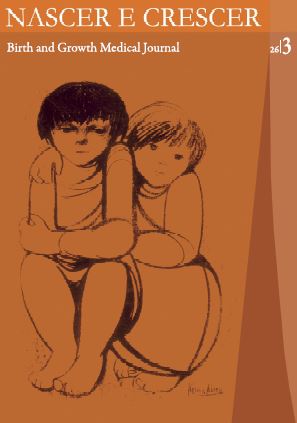Breastfeeding: changes after 12 years
DOI:
https://doi.org/10.25753/BirthGrowthMJ.v26.i3.13491Keywords:
Breastfeeding, breastfeeding epidemiology, newbornAbstract
Introduction: In recent decades initiatives for the promotion and protection of breastfeeding (BF) have been developed. This study was designed to evaluate the BF maintenance rate in a differentiated perinatal support hospital and compare results with those obtained in previous and similar studies.
Methodology: Longitudinal prospective study including a convenience sample of newborns admitted to a maternity, from 1 February, to 30 April, 2012. Sociodemographic, perinatal and determinants of BF interruption data were collected in maternity, at three and six months and compared with similar data evaluated in studies conducted in 2000 and 2003 at the same institution.
Results: Two hundred and ninety two mother/child pairs were included. Comparing with studies of 2000 and 2003, mothers had a higher mean age and educational level. In relation to the study of 2000, there was an increase in the preterm percentage and a reduction of caesarean section, infant formula needs and time to BF onset. It was found an improvement in BF rate at discharge compared to 2003. The hypogalactea remained the main cause of BF cessation. At six months, the BF interruption decision was mostly taken by the mother.
Discussion/Conclusion: The demographic changes aware to the emergence of possibly different difficulties in BF promoting. At the hospital, reduction of infant formula use and time to BF onset represented improvements in this area. Such results highlight the importance of BF efforts over the years and must encourage other similar initiatives after discharge.
Downloads
References
World Health Organization. Expert consultation on the optimal duration of exclusive breastfeeding. 28-30 March. Genebra 2001.
Levy L, Bertolo H. Manual de Aleitamento Materno. Comité Português para a UNICEF. Edição revista 2008; p.1-41.
Aguiar H, Silva A. Aleitamento Materno - A Importância de Intervir. Acta Med Port 2011; 24:889-96.
Schanler RJ. Maternal and economic benefits of breastfeeding. In: UpToDate; 2010. (Acedido em 16 de Agosto de 2013). Disponível em http://www.uptodate.com.
Kambale MJ. Social determinantes of breastfeeding in Italy. African Healths Sciences. 2011; 11:508-17.
Barge S, Carvalho M. Prevalência e fatores condicionantes do aleitamento materno-Estudo ALMAT. Revista Portuguesa de Clínica Geral 2011; 27518-25.
Sandes AR, Nascimento C, Figueira J, Gouveia R, Valente S, Martins S, et al. Aleitamento materno: prevalência e factores condicionantes. Acta Med Port 2007; 20:193-200.
World Health Organization. Breastfeeding: Only 1 in 5 countries fully implement WHO´s infant formula code.(Acedido em 27 de janeiro de 2014). Disponível em http://www.who.int/mediacentre/news/releases/2013/world_breastfeeding_week_20130730/en/
Branco AS, Bastardo C, Albuquerque M, Oliveira G. Aleitamento materno: A prática hospitalar e o sucesso das medidas de implementação do aleitamento até aos 6 meses de vida. Acta Pediatr Port 2004; 35:441-7.
Brito H, Alexandrino A, Godinho C, Santos G. Experiência do aleitamento materno. Acta Pediátrica Portuguesa 2011; 42:209-14.
Instituto Nacional de Estatística. Estatística no Feminino. Ser Mulher em Portugal, 2001-2011, INE; 2012: p. 5.
Caldeira T, Moreira P, Pinto E. Aleitamento materno: estudo dos factores relacionados com o seu abandono. Rev Port Clin Geral 2007; 23:685-99.
Thulier D, Mercer J. Variables associated with Breastfeeding Duration. Journal of Obstetric, Gynecologic & Neonatal Nursing 2009;38:259-68.
Shealy KR, Li R, Benton-Davis S, Grummer-Strawn LM. The CDC Guide to Breastfeeding Interventions. US Department of Health and Human Services. Disponível em: http://www.cdc.gov/breastfeeding/pdf/breastfeeding_interventions.pdf 2005.
Britton C, Mccormick FM, Renfrew MJ, Wade A, King SE. Support for Breastfeeding Mothers. Cochrane Database Syst Rev 2007;24:CD001141.
Prior E, Santhakumaran S, Gale C, Philipps LH, Modi N, Hyde MJ. Breastfeeding after cesarean delivery: a systematic review and meta-analysis of world literature. Am J Clin Nutr 2012; 95:1113–35.
Edmond K, Zandoh C, Quigley MA, Etego SA, Agyei SO, Kirkwood BR. Delayed Breastfeeding Initiation Increases Risk of Neonatal Mortality. Pediatrics 2006; 117:380-6.
Lamounier JA. O efeito de bicos e chupetas no aleitamento. Jornal de Pediatria 2003; 79: 284-6.
Neto E, Oliveira A, Zandonade E, Molina M. Pacifier use as a risk factor for reduction in breastfeeding duration: a systematic review. Rev Bras Saude Matern Infant 2008; 8: 377-89.
Karabulut E, Yalçin SS, Özdemir-Geyik P, Karaagaoglu E. Effect of pacifier use on exclusive and any breastfeeding: a meta-analysis. The Turkish Journal of Pediatrics 2009; 51:35-43.
Kair LR, Kenron D, Etheredge K, Jaffe A, Phillipi CA. Pacifier Restriction and Exclusive Breastfeeding. Pediatrics 2013; 131:e1101–7.
Sociedade Portuguesa de Pediatria. Recomendações - Síndrome de Morte Súbita do Lactente. SPP 2009; 1-3. Disponível em: http://www.spp.pt/UserFiles/File/Noticias/Document1.pdf.
Sarafana S, Abecasis F, Tavares A, Soares I, Gomes A. Aleitamento materno: evolução na última década. Acta Pediátrica Portuguesa 2006; 1:9-14
Downloads
How to Cite
Issue
Section
License
Copyright and access
This journal offers immediate free access to its content, following the principle that providing free scientific knowledge to the public provides greater global democratization of knowledge.
The works are licensed under a Creative Commons Attribution Non-commercial 4.0 International license.
Nascer e Crescer – Birth and Growth Medical Journal do not charge any submission or processing fee to the articles submitted.


